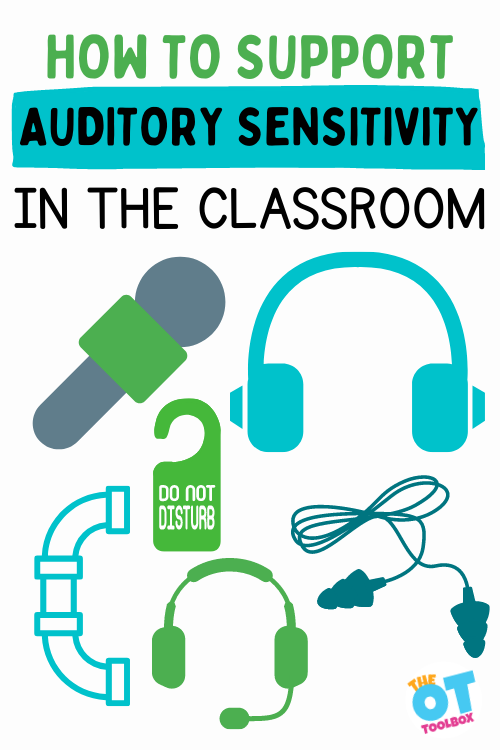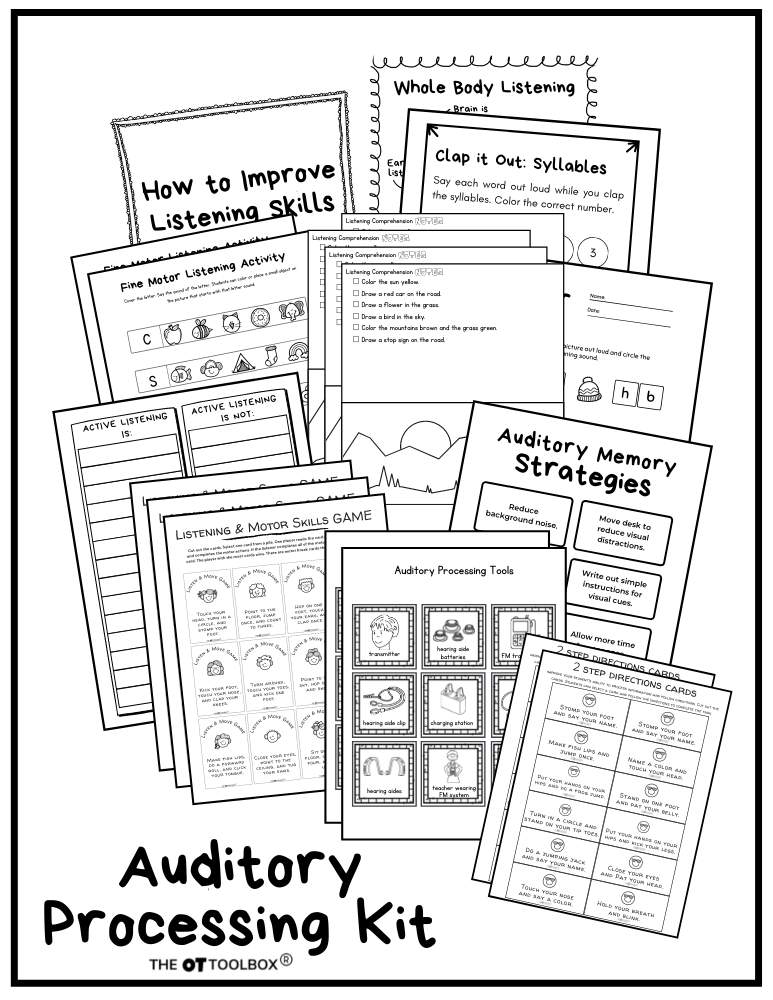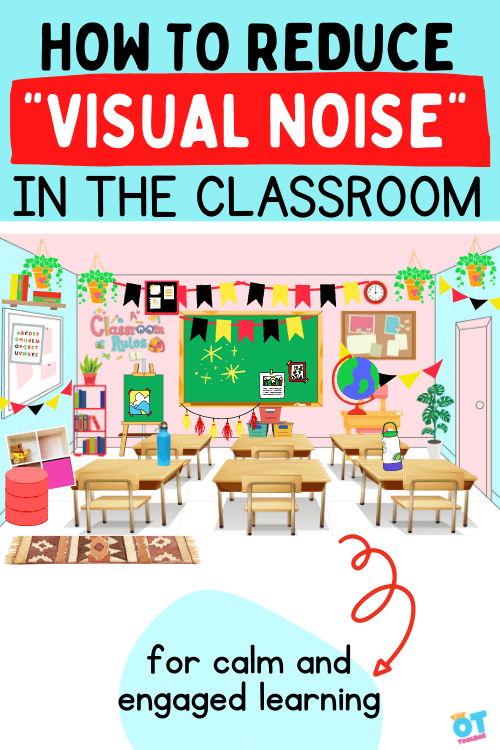In this blog post, we are covering an important aspect of the classroom environment: auditory sensitivity. Students with auditory sensory overload are challenged to learn and participate in classroom activities, and not only that, auditory sensitivities, or sound sensitivity can lead to anxiety, overwhelm, avoidance, self-regulation issues, and social emotional considerations. Let’s discuss auditory processing with the focus on classroom sounds with sensory tips and strategies, as well as supports to set up a classroom for success. This blog post is a great resource aligned with our post on visual noise in the classroom.

What is Auditory Sensitivity?
First, it’s important to consider what auditory sensitivity means. Basically, we are referring to sensitivities to sounds, or an over-awareness of the noises around us. A noise sensitivity can lead to discomfort in the ears as well as repercussions throughout the whole body as a result of anxiety, worry, overwhelm, and hyperawareness of auditory input.
There’s more to it, though. Auditory sensitivity can refer to a hyper-awareness of sounds, a buzzing sound or tinnitus in the ears, or other considerations. Here are some red flags indicating auditory sensitivities are present:
Red flags for auditory sensitivity:
- Overly upset over loud sounds
- Anxious that loud noises will happen
- Complains of buzzing in the ears, or tinnitus
- Hyper-aware of noises happening in other rooms
- Overwhelmed by conversations happening around us
- Complains of discomfort as a result of sounds
- Normal hearing but also overly aware of certain pitches of sounds or certain decibels of sounds
- Scared of the fire alarm or door alarms, or fire drills
- Hearing loss
- Overly concerned about everyday sounds
- Prefers social isolation due to potential for certain sounds
- Increased sensitivity to sounds that most do not consider to be a distraction: the heater buzzing, a refrigerator humming, lawnmower running outside, etc.
- Challenges with daily life due to sounds
There can be more red flags related to noise sensitivity, and these are all very individualized. No two individuals will present with the same auditory sensitivities due to personal preferences, environment, and personal experiences.
Diagnoses with auditory sensitivities
Sensitivity to auditory input can be common with certain diagnoses. However, the list below is not exhaustive, meaning there can be other diagnoses that also have a sound sensitivity. Also, being overly aware of sounds to the point that the sensory preference impacts daily life functioning does not indicate that a diagnosis is present. It simply means that the individual has that particular sensory preference.
Diagnoses that may have sound preferences:
- Autism
- Sensory Processing Disorder
- Multiple Sclerosis (MS)
- Lyme Disease
- Depression
- Head Injury
- Phonophobia
Auditory hypersensitivity can be present in other diagnoses as well.
How to test for auditory sensitivity
Because auditory preferences are so individualized, it’s important to seek out testing, particularly when the sensory preference impacts daily functioning or learning.
One such tool in an individual’s toolbox is the occupational therapy practitioner. An OT can complete a sensory preferences profile using specific tests, interviews, and checklists as well as assessments to discover sensory preferences. They can then provide tools and strategies to support those auditory preferences.
It’s also important to seek out evaluation from an audiologist. This professional can determine the frequency range the individual can hear using equipment and a sound stimulus.
Auditory Sensitivity in the Classroom
Students are VERY busy! Whether they are at home, school, or out in the community, children are affected by their surroundings. Setting up a preschool classroom for success is essential.
The environment can make children “hyper”, or calm them down. Sometimes preschool (and older kids) have ears sensitive to noise that impact learning and participation in their education.
Noise impacts a child’s ability to calm, that can be modified by adults in any environment. We are going to dive into how to support children who are sensitive to noise throughout this blog!
Setting up a Preschool Classroom for Success
Have you ever noticed when there is a lot going on, children tend to lose focus? A child sensitive to loud noises will be challenged to be successful in the classroom environment because the sensory need takes priority. Adults, when they have multiple senses engaged, can be overwhelmed by chaos as well.
This is especially true when there is overwhelming auditory input.
One way to look at this concept is by experience. This is overstimulation in adults that we have all experienced at one point or another.
Think about an amusement park and all of the sounds happening around you in a noisy crowd. While one of my favorite places to go is an amusement park, it can be very overwhelming! I love the rides and the shows.
But, when I go to the food court, I start to get overwhelmed. Children are usually crying because they are hungry, parents are annoyed, people are talking on their phone as they wait in 30 minute lines for a $10 hot dog, and there are attendants screaming “next”, or “move along!”
There is so much going on auditorily, that many adults get frustrated, and want to find a quiet corner to eat with their family.
Just like a noisy dining hall, a classroom sensitivity can be overwhelming for some students.
That’s where tools for auditory sensitivity for the classroom come into play.
But before we explore the various tools for auditory sensitivities, we should consider what the auditory impact of the classroom is and how that input can impact learning, social emotional skills, communication, and daily functioning.
What is the noise like in your Classroom?
In a typical preschool classroom there might be 24 or more children running around, laughing and screaming, while a CD player is playing rambunctious music, and parents are talking about what their child had for breakfast. The preschool setup can become very noisy.
In an elementary classroom, you may have more towards 28 or more students. Kids having conversations, dropping books, running the electric pencil sharpener, screeching tennis shoes, or scraping chairs. Then there is the announcements over the loud speaker, teacher instructions, hallway noises, and the lawn mower outside the classroom window. It can get noisy, quick!
With different types of sounds echoing throughout the classroom, auditory overstimulation can affect behavior and engagement. For ears sensitive to noise, this can be huge.
According to an exploration of sensory processing and the limbic system, the sensory system receives sensory messages, like sound, and directs them to the part of the brain that needs to process them. This process is also responsible for keeping your body safe. Sometimes it will trigger an automatic safety response called a ‘fight, flight or freeze’ response.
This response is a protective mechanism based on our ancient ancestors who had to be on constant alert for saber tooth tigers rustling bushes. While we no longer need to worry about the threat of danger lingering in our periphery, we have this awareness of auditory input that keeps us safe in other ways. Our brain and body regulate the sensory input that comes in so it’s not too overwhelming for us.
An example; when you jump if you hear an unexpected sound. The “sensory traffic controller” in the brain tunes in to help locate and identify the sound. You may be instantly more alert if you hear your head teacher, or manager’s voice. Researchers think this part of the brain processes sounds differently in children or adults who are overwhelmed by sounds, noise, or auditory sensory input.
Auditory overload often occurs when there are too many sounds happening at the same time, or if the noise is at a certain frequency. In addition, the brain can also become overwhelmed by a constant noise which has occurred over a period of time. This information is important when setting up a preschool classroom.
Tips for setting Up a Preschool Classroom
Once you have an understanding of what sound input is like in your classroom setting, you can then explore tools for auditory sensitivity.
In order to create a calm preschool classroom environment, the sound needs to be purposeful! Being cognizant of all of the different environmental sounds, is key to creating a soothing classroom.
Consider the classroom set up
The classroom arrangement can impact auditory sensitivities, as well as how and where various tools for auditory sensitivity are available in the school setting.
Here are aspects of your preschool classroom setup to keep in mind when addressing noise:
- Music – Depending on the time of day, music is a wonderful addition to any classroom. This can be through singing or the electronic media. Use calming/soft music to calm down a classroom during free play and nap time. This can include nature sounds, white noise, soft melodies and children’s music.
- Echoing noise – Every classroom is created differently, keep track of where there may some extra echoes. Hearing noise from multiple places at once can be very overwhelming, especially when echoes are coming from multiple children. This can be important when it comes to hallway noises, outside noises (lawnmowers), or echo within the classroom. Some ideas to support echo sensitivity include adding padding to the bottoms of shoes or desks. Felt sheets or foam sheets are inexpensive options for this. Other things to consider is going into the cafeteria, gymnasium, or area with higher ceilings and larger groups of children such as special events.
- Sensory Headphones- One tool to support students with sensitive ears is a pair of sensory headphones. There are many on the market that can reduce the auditory stress of a child in the day to day noise of a classroom. Other options include sensory noise-reducing earplugs and noise cancelling headphones. To increase sounds try a DIY whisper phone.
- Consider Other Students – Children are noisy, especially during free play! When indoors, encourage children to use an inside voice, while they are playing and talking. When children are focused and engaged, they tend do this naturally. Creating learning centers that support engagement is the best way to keep noise down, and children learning. Some children who have difficulty regulating their verbal output may need extra help in this area. Check out all of the learning stations (block, art, science, manipulative, sensory, dramatic play) ideas on how to set up your classroom by the age of the children you teach in this Early Childhood Environmental Rating Scale.
- Consider Other Adults – Keeping tabs the adults in the room is key when thinking about the noise in a classroom. Caregivers tend to talk loudly when around a lot of children, either to get their attention, or intervene when they see a problem about to occur. If caregivers practice talking to children, while getting down to their level, and making eye contact, the level of our voices naturally decrease. You can also try a “do not disturb” sign in the door during important lessons or instructional periods. Consider these auditory attention activities.
- Consider Classroom Pets – Classroom pets are wonderful additions when setting up a preschool classroom. Although they are fun, they can also be noisy! The most popular classroom additions are fish tanks and guinea pigs. The sounds of the bubbles can be soothing for some, but loud to others. Guinea pigs are quiet until they start shuffling around and squeaking. When thinking about where to place a fish tank or cage, keep in mind where the children will nap, and where the quiet spaces are.
- Small group activities – When children are actively engaged in activities as a group, their voices tend to become loud. This is a great time to teach children how to turn taking skills, by waiting for others to ask questions. Allowing children to communicate with each other, have discussions, and engage in play, is more productive when they are using their inside voices.
- Consider the classroom sound system- There are many options when it comes to auditory needs in the classroom. We talked about the low tech strategies above, but along those same lines is a “high tech” classroom auditory system. This can include things like wireless voice amplifier for teachers, a classroom sound system with wireless microphone, a classroom speaker system, a voice amplifier for classroom, and other technical pieces of equipment.
Auditory input can affect behavior
Young children can feel overwhelmed by many environmental components. This can affect their behavior at home, and in the classroom. The sensory system, and the way the brain processes information, varies for each person. The ability to respond to the environment, greatly depends on how sensitive you are to sensory stimuli.
The OT Toolbox has a great sensory processing checklist to better understand the sensory systems. You can learn more about this sensory processing checklist here.
What happens when a child is so overstimulated by their environment, they are nor able to calm down, without being redirected?
One strategy is having a safe space such as a calm down corner. Consider setting up a preschool classroom with a calming area.
Including a space in your classroom or home that allows children to take a break form their environment, along with using calming techniques (such as deep breaths, squeezing a ball, sipping water), are wonderful ways to help a child center themselves, so they can reintegrate into the classroom in a more calm state of mind.
Enourage the use of visual, tactile and auditory calm down cues when setting up a preschool classroom, that two year olds understand.
*If you notice a child having a hard time calming down, even with the removal of noise, they may have more sensitivities to stimuli than others. This is a sign that an Occupational Therapy evaluation might be appropriate, to determine if they need more supports with their sensory system. The occupational therapist will review the sensory systems, triggers, and behavioral outcomes.
A therapist may then suggest a sensory diet as part of the plan. For more information about a sensory diet, check out this search on the OT Toolbox. In addition, this amazing printable includes 130 different ideas on introducing a sensory diet for your child.
Auditory classroom management is just one aspect of setting up a preschool classroom
Other aspects to consider are:
- visual input – is your class cluttered, messy, or busy
- tactile – is there a lot of touching going on, are children in close proximity
- olfactory – what are all the good/bad smells in the class
- vestibular – are there times for movement breaks and outlets for energy
Preschool classrooms are a lot of fun, and children are born to be noisy, but if caregivers take the time to create a classroom that has more soothing sounds indoors, children learn to socialize in a calm way. This allows for classroom management to be easier and more productive, supporting every child’s needs. When planning your classroom, home environment, or an outing with your child, notice the auditory stimuli, and how it is affecting your child.
Free Handout: Classroom Auditory Sensitivity Strategies
One tool for auditory sensitivity is the free printable you’ll find below.
We’re coming up on the end of our Summer Handout Series here on the OT Toolbox. Want to print of a list of strategies to support auditory sensitivities in the classroom? Use this printable handout as an educational tool to support auditory needs.
This handout is also available inside our Member’s Club. Just go to the handouts section to grab it without entering your email address.
Get the handout by entering your email address into the form below:

Jeana Kinne is a veteran preschool teacher and director. She has over 20 years of experience in the Early Childhood Education field. Her Bachelors Degree is in Child Development and her Masters Degree is in Early Childhood Education. She has spent over 10 years as a coach, working with Parents and Preschool Teachers, and another 10 years working with infants and toddlers with special needs. She is also the author of the “Sammy the Golden Dog” series, teaching children important skills through play.
The Auditory Processing Kit is one tool to support auditory needs. Use this auditory processing kit to support learners with hyper-responsive or hypo-responsive auditory systems. Use the hands-on activities to support learning and active listening through play and handwriting tasks. Use the handouts and posters to teach about the auditory system and auditory sensitivities, with strategies to support individualized needs.
The Auditory Processing Kit supports listening and comprehension activities into multisensory learning styles.




